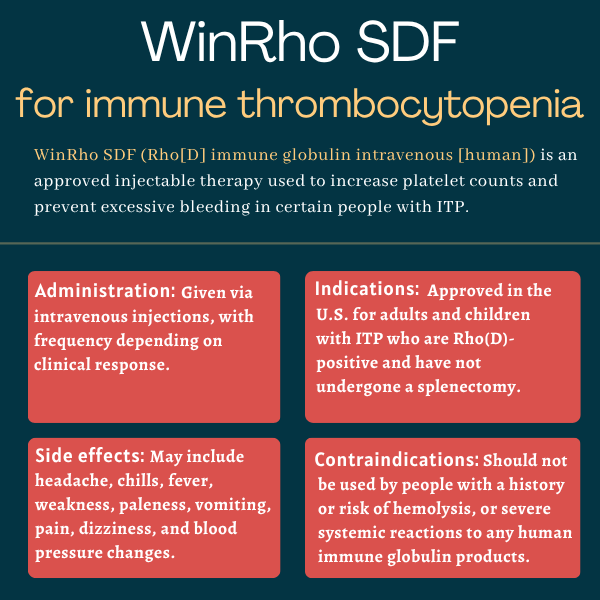
WinRho SDF (Rho[D] intravenous immune globulin [human]) for immune thrombocytopenia
Last updated July 10, 2025, by Lindsey Shapiro, PhD

What is WinRho SDF for immune thrombocytopenia?
WinRho SDF (Rho[D] immune globulin intravenous [human]) is an injection medication approved for certain children and adults with immune thrombocytopenia (ITP) who have not undergone a splenectomy, or removal of the spleen.
It’s given intravenously, or via injections into the bloodstream, and is expected to increase platelet counts and prevent excessive bleeding in individuals with ITP.
In ITP, the immune system mistakenly targets and attacks healthy platelets, the cell fragments needed for blood clotting, via self-reactive antibodies. These autoantibodies bind to the platelets and mark them for destruction by immune macrophages in the spleen.
WinRho SDF is derived from human blood and contains antibodies (immune globulins) against the Rho(D) protein, which is found on the surface of red blood cells. Whether or not someone has this protein helps determine their blood type — for example, someone with A-positive blood has the Rho(D) protein, while someone who’s type A-negative does not.
It’s thought that WinRho SDF works in ITP by coating a person’s Rho(D)-positive red blood cells with antibodies, prompting macrophages in the spleen to bind to them. With macrophages otherwise occupied, they won’t attack a person’s antibody-coated platelets, prolonging platelet survival.
WinRho SDF is marketed in the U.S. by Kamada Pharmaceuticals. The therapy is also used to prevent immune reactions when Rho(D)-negative people are exposed to Rho(D)-positive blood.
Therapy snapshot
| Brand name: | WinRho SDF |
| Chemical name: | Rho(D) immune globulin intravenous (human) |
| Usage: | Used to increase platelet levels and lower the risk of bleeding in some people with ITP |
| Administration: | Intravenous injection |
Who with immune thrombocytopenia can take WinRho SDF?
WinRho SDF is approved in the U.S. for certain people with ITP who are Rho(D)-positive and haven’t had their spleen removed. Among potentially eligible patients are:
- children with chronic or acute ITP
- adults with chronic ITP
- children and adults with ITP secondary to HIV infection.
Because WinRho SDF directs the immune system toward red blood cells, it comes with a boxed warning that it can cause serious or life-threatening incidents of intravascular hemolysis (IVH) — red blood cell destruction within blood vessels — in people with ITP.
As such, WinRho SDF is contraindicated, or should not be used, for people who already have or are at risk of hemolysis, or those who have autoimmune hemolytic anemia, a condition in which the immune system attacks the body’s own red blood cells. It is also contraindicated for:
- people with a history of severe systemic reactions or anaphylaxis (a life-threatening allergic reaction) to human immune globulin products
- IgA antibody-deficient individuals who have anti-IgA antibodies or a history of hypersensitivity reactions (unwanted, adverse immune responses) to WinRho SDF or any of its components.
How is WinRho SDF administered in immune thrombocytopenia?
WinRho SDF is given via injections into the bloodstream, which are administered by a healthcare provider. The injections last about three to five minutes, but patients will be monitored for at least eight hours for potential complications.
The medication is given at a dose determined by a healthcare provider, with the dosage typically based on a person’s weight and blood levels of hemoglobin, an indicator of how many healthy red blood cells an individual has. Dosing frequency depends on the person’s clinical response.

WinRho SDF in immune thrombocytopenia clinical trials
Clinical trials have demonstrated the effectiveness of WinRho SDF in increasing platelet counts in the four ITP patient populations for which the medication is approved. All patients in these studies were Rho(D)-positive and had an intact spleen.
- An open-label study tested increasing doses of the medication in 24 children with chronic ITP, meaning they had been diagnosed more than six months before their enrollment. Nearly 80% of these children experienced a meaningful platelet count increase, and these responses lasted more than one month, on average.
- Another study involved 146 children with acute ITP, and compared WinRho SDF with intravenous immunoglobulin G or oral prednisone. Data showed similar increases in platelet levels and similar times to reaching specific platelet threshold levels with both treatments.
- An open-label study investigated WinRho SDF in 24 adults with chronic ITP. These patients started the trial with fewer than 30,000 platelets per cubic millimeter of blood, but 88% responded to the first two courses of treatment, with the mean platelet count reaching 92.300 platelets/cubic millimeter.
- A fourth, open-label trial, in which both participants and researchers know the medication being given, enrolled 11 children and 52 adults with HIV-related ITP. The participants received an average of seven treatment courses over about 13 months. The data showed that 90% responded during the first six courses of WinRho SDF.
Common side effects of WinRho SDF
The most common side effects of WinRho SDF are:
- headache
- chills
- fever
- weakness, lack of energy, or general feelings of being unwell
- paleness (pallor)
- diarrhea, nausea, or vomiting
- pain in the joints, muscles, abdomen, or back
- dizziness
- involuntary movements or restlessness
- low or high blood pressure
- elevated blood cholesterol
- sleepiness
- blood vessel widening
- itching
- rash
- sweating.
Rare cases of IVH have been reported in people with ITP who were given WinRho SDF. The condition can lead to complications such as severe anemia, or a lack of healthy red blood cells, organ failure, and disseminated intravascular coagulation, which is a serious abnormal blood clotting response. Death has also occurred due to IVH.
Per the boxed warning, ITP patients should be closely monitored in a healthcare setting for at least eight hours after an injection. Patients should immediately alert a healthcare provider if they experience signs of IVH at any time. Such signs may include back pain, shaking chills, fever, discolored urine, and decreased urine output.
Other possibly serious side effects that can happen with WinRho SDF include:
- severe hypersensitivity reactions, including anaphylaxis
- transmission of infectious agents, because the treatment is derived from human blood
- acute kidney dysfunction or failure
- acute lung injury.
Patients will be monitored for the occurrence of these complications, especially if they have any known risk factors. WinRho SDF can also interfere with the results of some blood tests, including at-home blood sugar monitoring, so patients should talk with their physician about appropriate testing systems.
Bleeding Disorders News is strictly a news and information website about the disease. It does not provide medical advice, diagnosis, or treatment. This content is not intended to be a substitute for professional medical advice, diagnosis, or treatment. Always seek the advice of your physician or other qualified health provider with any questions you may have regarding a medical condition. Never disregard professional medical advice or delay in seeking it because of something you have read on this website.
Recent Posts
- ITP treatment Doptelet may help prevent bone loss in osteoporosis
- Bleeding risk high soon after kidney transplant in VWD, hemophilia A
- Combined therapy aids recovery for woman with TTP and lupus
- An ITP diagnosis wasn’t the final word on my health setbacks
- Cell therapy QT-019B shows strong response rate in hard-to-treat ITP
Related articles
-

-
-

THROMBOTIC THROMBOCYTOPENIC PURPURA
NewsCombined therapy aids recovery for woman with TTP and lupus
-
-
-




